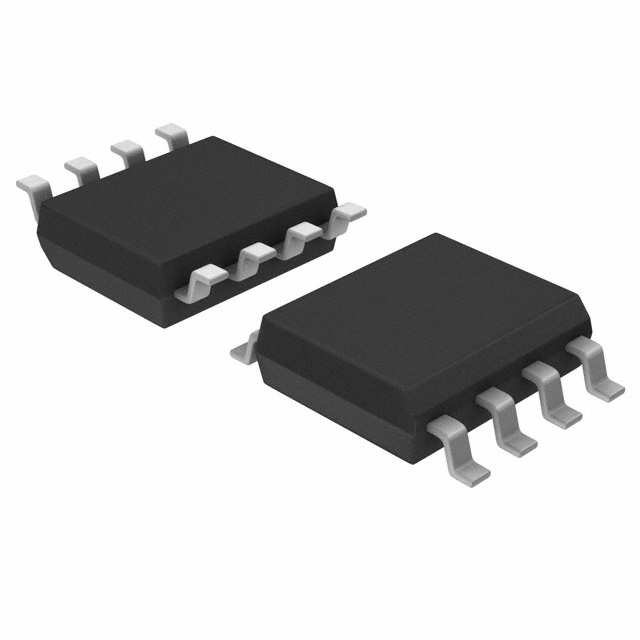Viz Specifikace pro podrobnosti o produktu.

LM2903QDR
Product Overview
Category: Integrated Circuits (ICs)
Use: LM2903QDR is a dual differential comparator designed for use in industrial, automotive, and consumer applications. It is commonly used in voltage level detection, signal conditioning, and analog-to-digital conversion circuits.
Characteristics: - Low input offset voltage - Low input bias current - Wide supply voltage range - Rail-to-rail output swing capability - High-speed response time
Package: SOIC-8
Essence: The LM2903QDR is an essential component in electronic circuits that require precise comparison of two input voltages. It provides accurate and reliable results in various applications.
Packaging/Quantity: The LM2903QDR is available in tape and reel packaging with 2500 units per reel.
Specifications
- Supply Voltage Range: 2V to 36V
- Input Offset Voltage: ±1mV
- Input Bias Current: ±25nA
- Response Time: 1.3μs
- Output Current: 20mA
- Operating Temperature Range: -40°C to +125°C
Pin Configuration
The LM2903QDR has a total of 8 pins arranged as follows:
```
| | --| IN(-) 1|-- VCC+ --| IN(+) 2|-- OUT --| GND 3|-- IN(-) --| OUT 4|-- IN(+) --| VCC- 5|-- GND --| NC 6|-- NC |__________| ```
Functional Features
- Dual Differential Comparator: The LM2903QDR consists of two independent comparators that can be used simultaneously or individually.
- Wide Supply Voltage Range: It operates from 2V to 36V, making it suitable for various power supply configurations.
- Rail-to-Rail Output Swing: The output voltage can swing close to the supply rails, allowing for maximum utilization of the available voltage range.
- Low Input Offset Voltage and Bias Current: These characteristics ensure accurate and precise comparison of input voltages.
- High-Speed Response Time: With a response time of 1.3μs, the LM2903QDR enables fast and efficient signal processing.
Advantages
- Versatile application in industrial, automotive, and consumer electronics.
- Reliable performance with low input offset voltage and bias current.
- Wide supply voltage range allows for flexible power supply options.
- Rail-to-rail output swing capability maximizes signal range.
- High-speed response time ensures quick and accurate signal processing.
Disadvantages
- Limited number of comparators (dual) compared to some other models.
- Not suitable for applications requiring high precision or ultra-low power consumption.
Working Principles
The LM2903QDR works based on the principle of voltage comparison. It compares the voltages applied to its two input pins and produces an output voltage based on the result of this comparison. When the voltage at the non-inverting input (+) is higher than the voltage at the inverting input (-), the output goes high. Conversely, when the voltage at the inverting input (-) is higher, the output goes low.
Detailed Application Field Plans
The LM2903QDR finds extensive use in various applications, including:
- Voltage Level Detection: It is commonly used to detect and compare voltage levels in power supply circuits, battery monitoring systems, and voltage regulators.
- Signal Conditioning: The LM2903QDR is employed in signal conditioning circuits to amplify, filter, or shape analog signals before further processing.
- Analog-to-Digital Conversion: It plays a crucial role in analog-to-digital converters by comparing the input voltage with a reference voltage to determine the digital output.
Detailed and Complete Alternative Models
- LM393: A similar dual differential comparator with comparable specifications and pin configuration.
- LM311: A single differential comparator with higher speed and wider supply voltage range.
- LM339: A quad differential comparator offering four independent comparators in a single package.
These alternative models provide similar functionality and can be used as substitutes for the LM2903QDR depending on specific requirements.
In conclusion, the LM2903QDR is a versatile dual differential comparator widely used in industrial, automotive, and consumer applications. Its low input offset voltage, wide supply voltage range, and high-speed response time make it suitable for various voltage level detection and signal conditioning tasks. While it has limitations in terms of the number of comparators and precision, it remains a reliable choice for many electronic circuits.
Seznam 10 běžných otázek a odpovědí souvisejících s aplikací LM2903QDR v technických řešeních
Sure! Here are 10 common questions and answers related to the application of LM2903QDR in technical solutions:
1. What is LM2903QDR? - LM2903QDR is a dual differential comparator integrated circuit (IC) that is commonly used in various technical applications.
2. What is the operating voltage range of LM2903QDR? - The operating voltage range of LM2903QDR is typically between 2V and 36V.
3. What is the output current capability of LM2903QDR? - LM2903QDR has a typical output current capability of ±20mA.
4. Can LM2903QDR be used as a voltage comparator? - Yes, LM2903QDR can be used as a voltage comparator to compare two input voltages and provide a digital output based on their relative magnitudes.
5. How many comparators are there in LM2903QDR? - LM2903QDR consists of two independent comparators in a single package.
6. What is the input offset voltage of LM2903QDR? - The input offset voltage of LM2903QDR is typically around 2mV.
7. Is LM2903QDR suitable for low-power applications? - Yes, LM2903QDR is designed for low-power applications and has a low supply current consumption.
8. Can LM2903QDR operate in a wide temperature range? - Yes, LM2903QDR is capable of operating in a wide temperature range, typically from -40°C to +125°C.
9. What is the output voltage swing of LM2903QDR? - The output voltage swing of LM2903QDR typically ranges from near the negative supply voltage to within 1.5V of the positive supply voltage.
10. What are some common applications of LM2903QDR? - Some common applications of LM2903QDR include voltage level shifting, window comparators, analog-to-digital converters, motor control circuits, and battery chargers.
Please note that the answers provided here are general and may vary depending on specific datasheet specifications and application requirements.

